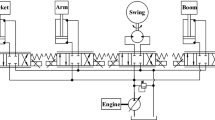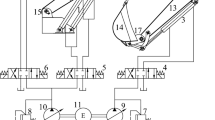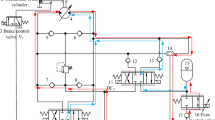Abstract
A new hydraulic hybrid excavator potential energy recovery system is proposed in this paper. The energy recovery system uses threechamber cylinders (TCCs) and accumulators to recover potential energy during work cycle. Within this structure, there is no throttle valve in the primary loop, and the recovered energy is stored in the form of hydraulic energy. Hence, energy loss of throttle valve and energy conversion process are avoided, and energy efficiency is improved. The mathematical model is established to analyze dynamic and energy recovery characteristics. From simulation analysis, the usage of accumulators and TCC influences the dynamic response and stability. The increase of accumulator volume weakens the control performance but heightens the stability. When the cross sectional area of the TCC increases, the control performance of the system are improved. In addition, the maximum power and energy consumption of pumps and engine with different accumulator volumes and different TCC diameters are obtained. Also, the maximum power and energy consumption of each pump and engine in different working conditions are obtained and compared with those without potential energy recovery system. According to the comparison, the potential energy recovery system can reduce the maximum power and energy of engine by 50%.
Similar content being viewed by others
Abbreviations
- A 11 :
-
cross sectional area of boom cylinder counterweight chamber
- A 12 :
-
cross sectional area of boom cylinder chamber without piston rod
- A 13 :
-
cross sectional area of boom cylinder chamber with piston rod
- B 1 :
-
viscous damping coefficient of boom cylinder
- C 11 :
-
external leakage coefficient of counterweight chamber
- C 12 :
-
internal leakage coefficient between counterweight chamber and the chamber with piston rod
- C 13 :
-
internal leakage coefficient between the chambers with and without piston rod
- C 14 :
-
external leakage coefficient of the chamber without piston rod
- C 15 :
-
external leakage coefficient of the chamber with piston rod
- C e :
-
equivalent viscous damping of engine
- C 1P :
-
sum of internal and external leakage coefficient of pump
- C ve :
-
compression loss coefficient of pump
- C vs :
-
structure leakage coefficient of pump
- D 1 :
-
viscous damping coefficient of boom
- D P :
-
displacement of pump
- d P :
-
diameter of pipe
- F 1 :
-
output force of boom cylinder
- F 2 :
-
output force of arm cylinder
- F 3 :
-
output force of bucket cylinder
- f 1 :
-
friction force of boom cylinder
- F load :
-
weight of load
- F G1 :
-
weight of boom
- F G2 :
-
weight of arm
- F G3 :
-
weight of bucket and load
- G 1 :
-
barycenter of boom
- G 2 :
-
barycenter of arm
- G 3 :
-
barycenter of bucket
- J 11 :
-
rotational inertia of boom rotating around point B
- J 12 :
-
rotational inertia of arm rotating around point B
- J 13 :
-
rotational inertia of bucket and load rotating around point B
- J e :
-
equivalent rotational inertia of engine
- J p :
-
equivalent rotational inertia of pump
References
Taymaz, I. and Benli, M., “Emissions and Fuel Economy for a Hybrid Vehicle,” Fuel, Vol. 115, pp. 812–817, 2014.
Salmasi, F. R., “Control Strategies for Hybrid Electric Vehicles: Evolution, Classification, Comparison, and Future Trends,” IEEE Transactions on Vehicular Technology, Vol. 56, No. 5, pp. 2393–2404, 2007.
Hippalgaonkar, R. and Ivantysynova, M., “A Series-Parallel Hydraulic Hybrid Mini-Excavator with Displacement Controlled Actuators,” Proc. of 13th Scandinavian International Conference on Fluid Power, pp. 31–42, 2013.
Zimmerman, J., Hippalgaonkar, R., and Ivantysynova, M., “Optimal Control for the Series-Parallel Displacement Controlled Hydraulic Hybrid Excavator,” Proc. of the ASME Dynamic Systems and Control Conference, pp. 129–136, 2011.
Sugimura, K. and Murrenhoff, H., “Hybrid Load Sensing–Displacement Controlled Architecture for Excavators,” Proc. of the 14th Scandinavian International Conference on Fluid Power, pp. 20–22, 2015.
Erkkilä, M., Bauer, F., and Feld, D., “Universal Energy Storage and Recovery System-A Novel Approach for Hydraulic Hybrid,” Proc. of 13th Scandinavian International Conference on Fluid Power, pp. 45–52, 2013.
Tikkanen S., To mmila H., “Hybrid pump drive,” The Fourteenth Scandinavian International Conference on Fluid Power, Tampere: Tampere University of Technology, pp. 667–677, 2015.
Quan, Z., Quan, L., and Zhang, J., “Review of Energy Efficient Direct Pump Controlled Cylinder Electro-Hydraulic Technology,” Renewable and Sustainable Energy Reviews, Vol. 35, pp. 336–346, 2014.
Jiang, J., Yu, A., and Shen, W., “The Review of Full Hydraulic Hybrid Excavator Based on Common Pressure Rail Network,” Chinese Hydraulics and Pneumatics, Vol. 9, pp. 44–49, 2010.
Shen, W., Jiang, J., Su, X., and Karimi, H. R., “Control Strategy Analysis of the Hydraulic Hybrid Excavator,” Journal of the Franklin Institute, Vol. 352, No. 2, pp. 541–561, 2015.
Shen, W. and Jiang, J.-H., “Analysis of Energy Recovery Efficiency of Hydraulic Hybrid Excavator,” Journal of South China University of Technology, Vol. 40, No. 1, pp. 82–87, 2012.
Lin, S.-w. and Hua, H.-y., “Constant-Pressure-Network Readjustment Hydraulic System design And Energy Consumption Analysis for Excavators,” Chinese Journal of Construction Machinery, Vol. 1, pp. 52–57, 2009.
Achten, P., Brink, T. V. D., Potma, J., Schellekens, M., Vael, G., and Innas, B., “A Four-Quadrant Hydraulic Transformer for Hybrid Vehicles,” Proc. of 11th Scandinavian International Conference on Fluid Power, 2009.
Shen, W. and Jiang, J., “Analysis and Development of the Hydraulic Secondary Regulation System Based on the CPR,” Proc. of International Conference on Fluid Power and Mechatronics, pp. 117–122, 2011.
Xiao, Y., Guan, C., and Lai, X., “Research on the Design and Control Strategy for a Flow-Coupling-Based Hydraulic Hybrid Excavator,” Proceedings of the Institution of Mechanical Engineers, Part D: Journal of Automobile Engineering, Vol. 228, No. 14, pp. 1675–1687, 2014.
Andersen, T. O., Hansen, M. R., and Pedersen, H. C., “Regeneration of Potential Energy in Hydraulic Forklift Trucks,” Proc. of Fluid Power Transmission and Control, pp. 302–306, 2005.
Huova, M., Laamanen, A., and Linjama, M., “Energy Efficiency of Three-Chamber Cylinder with Digital Valve System,” International Journal of Fluid Power, Vol. 11, No. 3, pp. 15–22, 2010.
Stauch, C., Schulz, F., Bruck, P., Rudolph, J., and Weg, G. E., “Energy Recovery Using a Digital Piston-Type Accumulator,” Proc. of the 5th Workshop on Digital Fluid Power. Tampere: Tampere University of Technology, pp. 57–73, 2012.
Sprengel, M. M. and Ivantysynova, M., “Investigation and Energetic Analysis of a Novel Hydraulic Hybrid Architecture for On-Road Vehicles,” Proc. of 13th Scandinavian International Conference on Fluid Power, pp. 87–98, 2013.
Lin, X., Pan, S.-x., and Wang, D.-y., “Dynamic Simulation and Optimal Control Strategy for a Parallel Hybrid Hydraulic Excavator,” Journal of Zhejiang University-Science A, Vol. 9, No. 5, pp. 624–632, 2008.
Bender, F. A., Kaszynski, M., and Sawodny, O., “Drive Cycle Prediction and Energy Management Optimization for Hybrid Hydraulic Vehicles,” IEEE Transactions on Vehicular Technology, Vol. 62, No. 8, pp. 3581–3592, 2013.
Xiao, Q., “Control Strategy and Parameter Matching OF Hybrid System in Hydraulic Excavator,” Zhejiang University, 2008.
Sinthipsomboon, K., Hunsacharoonroj, I., Khedari, J., Pongaen, W., and Pratumsuwan, P., “A Hybrid of Fuzzy and Fuzzy Self-Tuning PID Controller for Servo Electro-Hydraulic System,” Proc. of 6th IEEE Conference on Industrial Electronics and Applications (ICIEA), pp. 220–225, 2011.
Li, W., Cao, B., Zhu, Z., and Chen, G., “A Novel Energy Recovery System for Parallel Hybrid Hydraulic Excavator,” The Scientific World Journal, Vol. 2014, Article ID: 184909, 2014.
Zhang J., Li H. Y., Ma (B), et al, “Influence on Actuating Pressure Characteristics of Shift Clutch with Accumulator Regulating,” Chinese Hydraulics and Pneumatics, Vol. 3, pp. 96–99, 2013.
Li, W., Cao, B., Zhu, Z., and Chen, G., “A Novel Energy Recovery System for Parallel Hybrid Hydraulic Excavator,” The Scientific World Journal, Vol. 2014, Article ID: 184909, 2014.
Author information
Authors and Affiliations
Corresponding author
Rights and permissions
About this article
Cite this article
Zhao, PY., Chen, YL. & Zhou, H. Simulation analysis of potential energy recovery system of hydraulic hybrid excavator. Int. J. Precis. Eng. Manuf. 18, 1575–1589 (2017). https://doi.org/10.1007/s12541-017-0187-0
Received:
Revised:
Accepted:
Published:
Issue Date:
DOI: https://doi.org/10.1007/s12541-017-0187-0




